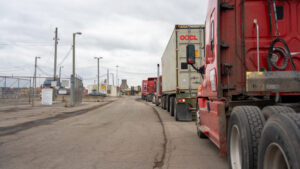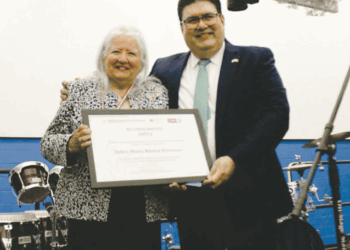At peak hours, trucks idle outside the facility, spewing exhaust as they unload and reload sunbleached shipping containers full of automotive parts, consumer products, food and chemicals – goods that are then transported across Detroit, the country, and into Canada.
The terminal serves as a gateway for trade between Detroit and international markets – a critical link in the global supply chain. It’s also a hard place to live for residents who have been exposed to the increasing pollution, noise, and dust caused by heavy truck traffic in their neighborhoods over decades.
Southwest Detroit residents have endured decades of pollution, noise and dust from freight trucks serving the Detroit Intermodal Freight Terminal, going back to as early as 1938. Now, a $112 million federal infrastructure grant aims to modernize and decarbonize the facility, promising cleaner air, reduced truck traffic, and improved quality of life.
While the project represents a significant investment in both the environment and the economy, some residents and advocates question whether these changes will sufficiently address long-standing community concerns or simply expand the terminal’s capacity at their expense.

The Detroit RECHARGED project aims to modernize and decarbonize the facility, reducing truck traffic and air pollution. Electric and hybrid cranes will replace diesel, yards will be paved, and approximately 17,200 feet of new rail track will be laid.
The project is a public-private partnership between the state, the city and rail freight company Norfolk Southern, which co-owns the facility with CSX Corporation. The U.S. Department of Transportation is contributing $67 million, with the remaining $45 million coming from the other partners.
Once completed at the end of 2027, the terminal will be one of the “most technologically advanced intermodal facilities in the country,” said Katie Byrd, Norfolk Southern’s assistant director of executive communications.
The project is part of the broader MDOT-led effort to reduce the environmental impacts of freight, according to a project report. Norfolk Southern pledged $1 million as part of a grant to the nonprofit community group Southwest Detroit Environmental Vision to help with community outreach, workforce development and small business enterprise engagement “to ensure the community directly benefits from this project as it is built and afterwards,” Byrd added.
The yard has been jointly operated since 1998 by Norfolk Southern and CSX Corporation. Norfolk Southern owns 67.5 acres on the east side of the train tracks, while CSX owns about 50 acres on the west side.
CSX does not plan to upgrade their equipment, though work to pave their portion of the yard has already started and is expected to be completed sometime next year, said Sam Krassenstein, chief of infrastructure for the city of Detroit.
Traffic flow near the CSX entrance at the intersection of Vernor Hwy, Dix St, and Waterman St, will improve under the Safe Streets grant. It will be designed next year and constructed in 2026 or the following year.
The city is also improving Livernois Ave as part of the Safe Streets grant in 2026 between Interstate-94 and I-75.
Project boosters say the improvements will benefit the economy and the environment.
“The Livernois Intermodal Facility project will strengthen our operations, drive economic growth, and create jobs in Detroit and the surrounding region,” Norfolk Southern President and CEO Mark George said in a statement. “This investment directly benefits the Southwest Detroit community by…reducing diesel emissions, improving air quality, and enhancing truck routes.”
For longtime Southwest Detroit resident Amanda Holiday, relief can’t come soon enough. She said dust gets in her family’s airways, causing her kids to have frequent ear infections.
“I have to take Zyrtec or Claritin or some kind of antihistamines every day, like every single day, and so do my young children,” she said. “I’m most excited about the paving of the yard, because the biggest thing we see as residents is the dust,” she said.

Skepticism remains
While proponents are hopeful that the investment will create jobs and improve local infrastructure, some residents and environmental advocates remain skeptical.
Livernois resident Thomasenia Weston has been impacted by incessant truck traffic for years, with the foundation of her home crumbling from the vibrations. While the project has different components on different timelines, significant improvements will be made in the next two to three years. The longer-term rail crossing work to separate Central St and Lonyo St is still about five years away from securing federal funding and construction, Krassenstein said.
“Two years is too long to wait. That’s an unreasonable ask of a community that’s already suffering to wait,” she said. “How will it further impact everything else that’s going on with the particulate matter? I’m asthmatic, and it seems like every couple of months it just grows.”
Andrew Bashi, staff attorney at Great Lakes Environmental Law Center, said he doubts that the project will actually keep trucks off residential streets and reduce pollution.
He said while he sees the value and benefit of electric cranes, he thinks those efficiency improvements could “pale in comparison” to the potential impacts of increasing the facility’s capacity. The project will increase capacity from to 250,000 containers annually, from 107,000.
Bashi criticized the project as “corporate welfare,” questioning why taxpayers should fund upgrades for a profitable company instead of directly supporting impacted residents.
But Geoff Lewis, climate and energy research area specialist lead and adjunct lecturer at the University of Michigan, said that rail is a quarter as energy-intensive as trucking and has a higher vehicle capacity, though trucks are necessary for reaching most final destinations.
“Depending on how far out we look, switching those diesel cranes to electric is an immediate benefit for the neighborhood, because the emissions are no longer happening there – they’re happening at the power plant,” Lewis said.
Noise pollution from trucks will still be an issue, Lewis said, though he thinks the paving of the yard will reduce dust and particulate matter.
Kristy Allen, project manager for air monitor company JustAir, said improvements like reducing diesel idling and yard paving can lower fine particulate matter, which is linked to heart and lung issues, premature death, and mental health problems. Particulate matter is 30 times smaller than the width of a human hair, and can enter the bloodstream when inhaled.
In May, JustAir installed an air monitor on John Kronk St., which recorded an average PM 2.5 (particulate matter with a diameter of 2.5 microns or less) concentration of 14 micrograms per cubic centimeter over six months—classified as “moderate” by the EPA. JustAir plans to add monitors on the east and south sides of the facility and encourages residents to track air quality using the JustAir app.
Poor air quality restricts outdoor activities and raises indoor air safety concerns, requiring costly upgrades like air filters and HVAC systems. “The air isn’t safe to breathe, forcing people indoors,” Allen said.
Krassenstein wants people to see “how much of a win” the project is for Southwest Detroit. His involvement in the project dates back six years, he said.
“We’ve been stuck with this facility in a state of disrepair, dirt and noise for the last two plus decades,” Krassenstein said.
Less idling, fewer short hauls, less pollution
Terminal upgrades are expected to cut truck idling, gate queuing, and emissions. Improved layout and increased storage capacity will enhance efficiency, enabling higher, narrower container stacking and reducing off-site storage needs, Krassenstein said.
From Monday to Friday, an average 436 trucks access the yard entrance at the intersection of Livernois Ave and Federal St. The majority come from northbound Livernois Ave after cutting through a dense residential neighborhood between the terminal and I-75, where Weston and Holiday live.
The improvements include a mandated left turn from the facility onto Livernois Ave, shunting exiting truck traffic away from residential streets toward I-94.

Today, each truck spends about 45 minutes in the facility. During peak hours, from 11 am to 2 pm, residents note trucks lining up outside of the facility entrance on Livernois Avenue.
Byrd said a Norfolk Southern contractor plans to implement and operate an appointment system, among other technology improvements, to eliminate backups onto residential streets.
With the increased storage capacity at the facility, fewer containers will need to be moved off-site, reducing short-haul traffic and the associated emissions from diesel trucks making repetitive short trips through residential streets, Krassenstein said.
As a result of fewer freight trucks making repetitive trips and reduced vehicle miles traveled, Zachary Kolodin, chief infrastructure officer of the Michigan Department of Transportation estimates 645,000 metric tons of carbon dioxide over a 20-year period will be avoided. This is equivalent to greenhouse gas emissions from 150,450 gasoline powered cars driven for one year, or greenhouse gas emissions avoided by 193 wind turbines running for one year.
“Truck backlog is not good for industry, community or railroads. It inhibits their ability to move cargo. This is not a trivial concern…because Southeast Michigan is the hub of the automotive industry,” Kolodin said.
Krassenstein emphasized that the increased capacity will enable the processing of more trains and rail cars, which he said could attract more business to rail over trucking and result in a net positive environmental impact.
“The more medium-and long-haul truck routes we can take off the road, the better for emissions,” he said, though he acknowledged that immediate changes to demand are unlikely.
What about that truck route ordinance?
Bashi said the city should prioritize implementing the truck route ordinance for Southwest proposed in 2023.
“The city could have done something very tangible and relatively easy by implementing a truck route, yet they didn’t,” Bashi said. “But then they’ll go to bat for a company to get millions and millions of dollars…to address some of those issues, when it could have been done very simply through an ordinance.”
The 2021 Southwest Detroit Truck Route Study was completed by the planning and engineering firm Giffels Webster for the city of Detroit, and offered several recommendations that echoed residents’ requests.
Residents say the clock is ticking to make changes to zoning rules or pass a truck route ordinance.
Southwest residents seek answers about Moroun-owned truck yard
A residential-zoned parcel has been leveled and fenced off, violating city ordinance. Residents are worried about more trucking coming to their neighborhood. Southwest Detroit residents convened last week at Donovan’s Pub seeking answers about recent activity at a property belonging to the Moroun-owned real estate company Crown Enterprises at Toledo and 25th Street. “We’re desperate,”…
Cynthia Mendez is tired of living with the noise, the vibrations and the soot from constant truck traffic coming past her home on Livernois in Southwest Detroit. The rumbling wakes her up at night, the vibrations have caused damage to the foundation of her home, and the soot cakes up on her vehicle and the…
Few in Detroit experience the hazards of diesel exhaust from idling trucks quite like residents on Southwest Detroit’s Woodmere Street. Among the offenders plaguing the area are trucks at a nearby grocery store, sausage factory, concrete company, a lot where truckers sometimes park and sleep for the night with their rigs running, and a truck…
But implementation of an ordinance study was delayed by city officials who cited the need for a city-wide study of trucks first. Ray Duncan, policy advisor for district 6 councilwoman Gabriela Santiago-Romero, said her office is scheduled to meet with the city in January for a detailed update on study findings and to plan next steps.
Today, the city of Detroit and Santiago-Romero are collecting Southwest residents’ input on the 2024 study – residents can take the survey here. Once the study is completed, the city will suggest recommendations for truck routes.
Holiday would like to see that ordinance in place.
“Literally, trucks can go on any street as long as there’s not a sign, so they could go down one way residential street, and as long as there’s not a sign, they have no directions on where they’re supposed to be,” she said. “So what are we going to do? Make, like, 5,000 signs for little streets, or let’s make an ordinance, right?”














































